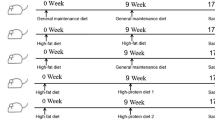Abstract
The aim of the present study was to investigate the histochemical effects of long-term soft diet in the medial pterygoid muscle as well as the two heads of the lateral pterygoid muscles in growing rabbits. Eleven young rabbits were divided into two groups as solid diet (control group; n = 6) or soft diet (soft-diet group; n = 5) groups. After 6 months, muscle fibers from the medial and the two heads of the lateral pterygoid muscles were histochemically defined. In the medial pterygoid muscle, the percentage of the type 1 fiber cross-sectional area to total area was 10.1 ± 2.4 % in the control group and 8.3 ± 3.0 % in the soft-diet group, respectively. In the soft-diet group, there was a trend toward an increase in the number of type 2A fibers, and toward a decrease in the numbers of type 2B fibers in comparison with the controls. In the two heads of the lateral pterygoid muscle, the percentage of the type 1 fiber cross-sectional area to total area was 8.4 ± 7.5 and 3.3 ± 2.7 %, respectively. Compared to that of the control group, the two heads in the soft-diet group showed a trend toward a decrease in the number of type 2A fibers. In addition, type 2B had a tendency to decrease in the number in the inferior head. In conclusion, this study suggests that long-term soft diet leads to adaptations of the pterygoid muscles. Two heads of the lateral pterygoid muscle revealed different adaptation from jaw-closing muscles under soft-diet conditions.










Similar content being viewed by others
References
Teuteberg HJ. Food patterns in the European past. Ann Nutr Metab. 1991;35:181–90.
Varrela J. Effects of attritive diet on craniofacial morphology: a cephalometric analysis of a Finnish skull sample. Eur J Orthod. 1990;12:219–23.
Varrela J. Dimensional variation of craniofacial structures in relation to changing masticatory-functional demands. Eur J Orthod. 1992;14:31–6.
Kitagawa Y, Mitera K, Ogasawara T, Nojyo Y, Miyauchi K, Sano K. Alteration in enzyme histochemical characteristics of the masseter muscle caused by long-term soft diet in growing rabbits. Oral Dis. 2004;10:271–6.
Engström C, Kiliaridis S, Thilander T. The relationship between masticatory function and craniofacial morphology. II A histologial study in the growing rat and soft diet. Eur J Orthod. 1986;8:271–9.
Shimizu Y, Ishida T, Hosomichi J, Kaneko S, Hatano K, Ono T. Soft diet causes greater alveolar osteopenia in the mandible than in the maxilla. Arch Oral Biol. 2013;58:907–11.
Langenbach G, van de Pavert S, Savalle W, Korfage H, van Eijden T. Influence of food consistency on the rabbit masseter muscle. Eur J Oral Sci. 2003;111:81–4.
Ito G, Mitani S, Kim JH. Effect of soft diets on craniofacial growth in mice. Anat Anz. 1988;165:151–66.
Maeda N, Kawasaki T, Osawa K, Yamamoto Y, Sumida H, Masuda T, Kumegawa M. Effects of long-term intake of a fine-grained diet on the mouse masseter muscles. Acta Anat (Basel). 1987;128:326–33.
Kiliaridis S, Engström C, Thilander B. Histochemical analysis of masticatory muscle in the growing rat after prolonged alteration in the consistency of the diet. Arch Oral Biol. 1988;33:187–93.
Luca L, Roberto D, Francesca SM, Francesca P. Consistency of diet and its effects on mandibular morphogenesis in the young rat. Prog Orthod. 2003;4:3–7.
Eriksson PO, Thornell LE. Histochemical and morphological muscle-fibre characteristics of the human masseter, the medial pterygoid and the temporal muscles. Arch Oral Biol. 1983;28:781–95.
Morita T, Fujiwara T, Maruo H, Negoro T, Kurata C, Kurita K, Goto S, Hiraba K. Abnormal movement of the mandibular condyle on the working side induced by artificially raising the unilateral bite and relation of the masseter and lateral pterygoid muscle activities to the abnormal condyle movement in rabbits. J Jpn Soc TMJ. 2008;20:139–50 (Japanese article with English abstract).
Takizawa M, Abe S, Ide Y. Muscle-fiber characteristics of the lateral pterygoid muscle in Japan. J Jpn Soc TMJ. 2002;14:269–75 (Japanese article with English abstract).
Mahan PE, Wilkinson TM, Gibbs CH, Mauderli A, Brannon LS. Superior and inferior bellies of the lateral pterygoid muscle EMG activity at basic jaw positions. J Prosthet Dent. 1983;50:710–8.
Lehr RP, Owens SE Jr. An electromyographic study of the human lateral pterygoid muscles. Anat Rec. 1980;196:441–8.
Kitagawa Y, Hashimoto K, Enomoto S, Shinoda S, Nojyo Y, Sano K, editors. Maxillofacial deformity and change in the histochemical characteristics of the masseter muscle after unilateral sectioning of the facial nerve in growing rabbits. Acta Histochem. Cytochem. 2002; 35: 305–12.
Dubowitz V. Normal muscle. In: Dobowitz V, editor. Muscle Biopsy. A Practical Approach, 2nd ed. Saunders: London. 1985. p. 41–81.
Kitagawa Y, Hashimoto K, Kuriyama H. Hypertrophic branchial myopathy with uniform predominance of type 1 fibers: case report. Scand J Plast Reconstr Surg Hand Surg. 2000;34:391–6.
Maxwell LC, McNamara JA Jr, Caelson DS, Faulkner JA. Histochemistry of fibres of masseter and temporalis muscles of edentulous monkeys Macaca mulatta. Arch Oral Biol. 1980;25:87–93.
Weijs WA, Brugman P, Grimbergen CA. Jaw movements and muscle activity during mastication in growing rabbits. Anat Rec. 1989;224:407–16.
Liu ZJ, Ikeda K, Harada S, Kasahara Y, Ito G. Functional properties of jaw and tongue muscles in rats fed a liquid after being weaned. J Dent Res. 1998;77:366–76.
Hiraba K, Hibino K, Hiranuma K, Negoro T. EMG activities of two heads of the human lateral pterygoid muscle in relation to mandibular condyle movement and biting force. J Neurophysiol. 2000;83:2120–37.
Conflict of interest
We as authors of this manuscript have no financial relationship with any organization as regards this study. We declare that we have no conflict of interest about in study. This study was partially supported by a Grant-in-Aid for Scientific Research (2010-2012: 22592203).
Author information
Authors and Affiliations
Corresponding author
Rights and permissions
About this article
Cite this article
Kitagawa, Y., Sato, J., Ogasawara, T. et al. Enzyme histochemical adaptive responses of the medial pterygoid muscle and two heads of the lateral pterygoid muscle to long-term soft diet feeding in growing rabbits. Odontology 102, 272–278 (2014). https://doi.org/10.1007/s10266-013-0127-0
Received:
Accepted:
Published:
Issue Date:
DOI: https://doi.org/10.1007/s10266-013-0127-0




